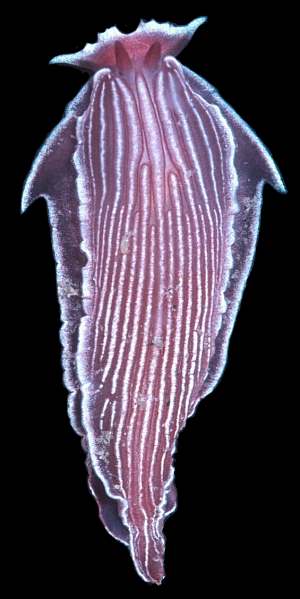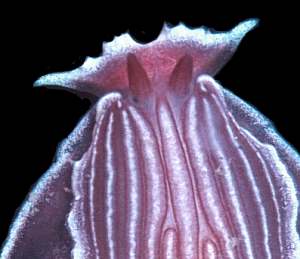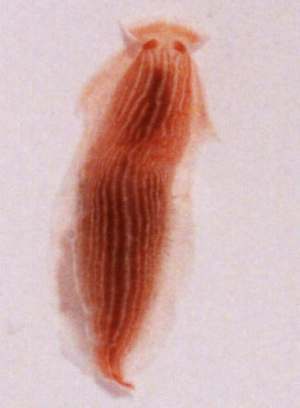
Dermatobranchus pulcherrimus
Miller & Willan, 1986
Order: NUDIBRANCHIA
Suborder: ARMININA
Family: Arminidae
DISTRIBUTION
Known from NE New Zealand and southern Australia [Victoria, Tasmania].
PHOTO
Paratype. Whangarei Harbour, northern New Zealand, on a sand bank at extreme low
tide. 29 mm extended crawling length. 17 May 1980. Photo: Richard Willan.
It is easily distinguishable by its reddish colour, described by Miller & Willan as 'burnt sienna'. In the original description. the longitudinal ridges and the edges of the foot, oral veil and mantle are described as opaque white. The oral veil is relatively large and its anterior corners are extended as short pointed tentacles. The foot is very broad for the genus, and the enlarged leading edge is developed into a large semicircular structure with tentacular foot corners. Most species of Dermatobranchus are found on hard substrates and the foot is about the same width as the mantle. It is possible that the very wide foot found in D. pulcherrimus is an adaptation to living in soft bottom habitats [see page on adaptations to living on sand & mud]. It grows to about 30mm in length.
Reference:
• Miller, M.C. & Willan, R.C. (1986) A review of the New Zealand arminacean nudibranchs (Opisthobranchia: Arminacea). New Zealand Journal of Zoology, 13: 377-408.
Rudman, W.B., 2002 (October 30) Dermatobranchus pulcherrimus Miller & Willan, 1986. [In] Sea Slug Forum. Australian Museum, Sydney. Available from http://www.seaslugforum.net/find/dermpulc
Related messages
Dermatobranchus pulcherrimus - type photo
November 5, 2002
From: Richard Willan

Dear Bill,
Here is a photograph of a Dermatobranchus pulcherrimus that you asked me for to
post on the Sea Slug Forum. This animal was one of the two that Michael Miller and I had when we described the species, and the one that we based our description of the external features and coloration on because it was alive and healthy when it was collected. Being part of the sample on which the species was named scientifically makes it a type specimen - a paratype in this case. This is a very unusual and distinctive Dermatobranchus species with the ragged extensions off the oral veil, the tentaculate foot corners, and the numerous longitudinal ridges on the mantle.
PHOTO: Whangarei Harbour, northern New Zealand, on a sand bank at extreme low
tide. 29 mm extended crawling length. 17 May 1980. Photo: Richard Willan.
The animal in Clinton Duffy's recent photograph is this same species. The colour of the body is actually burnt sienna rather than red. You mentioned that Clinton's animal seemed to lack opaque white pigment on the tops of the ridges as well as edges to the foot, oral veil and mantle. These opaque white areas, which are very obvious on the Whangarei animal, were probably also present on Clinton's animal but impossible to resolve in the photo because of the pale background on which it was was photographed.
Richard Willan
Richard.Willan@nt.gov.au
Willan, R.C., 2002 (Nov 5) Dermatobranchus pulcherrimus - type photo. [Message in] Sea Slug Forum. Australian Museum, Sydney. Available from http://www.seaslugforum.net/find/8354
Thanks Richard,
I have included alongside, an enlargement of the 'head' to show the oral veil, and the tapering rhinophores, more clearly. They are both rather unusual features for a species of Dermatobranchus.
Best wishes,
Bill Rudman
Dermatobranchus pulcherrimus from New Zealand
November 1, 2002
From: Clinton Duffy

Dear Bill,
I recently collected what to my eye was an unusual nudibranch in a grab sample from soft mud, 15 m depth, off Colville Bay, inner Hauraki Gulf, east coast of nthn New Zealand. After perusing a couple of nudibranch sites it appears to be a species of Dermatobranchus.
It was 30 mm long when crawling, red with fine longitudinal white lines, a broad white margin to the front of the foot and small dark red rhinophores. When crawling the foot behind the rhinophores was expanded into a small "wing" on either side of the body, before tapering rapidly to the "tail". I have taken a rather poor photograph of the live animal in a dish (no macro lens unfortunately). There was no epifauna in the grab and the animal's gut, visible through the body wall, appeared to be full. All in all an unusual little animal. I was particularly interested in Leanne Atkinson's observations of spawning in Armina, as a week or so earlier we collected a mysterious gelatinous mass that resembles the egg mass in her photos.
Station details: Inner Hauraki Gulf Survey: Station 6C Lat 36 37.57 S Long 175 23.97 E Depth 15.3 metres. 8 October 2002. Substrate Description: Surface layer of very soft brown mud with shell fragments. Firmer grey clay underneath. As in most other parts of the Gulf that we have surveyed, a video transect of the sea floor at this site suggested it was devoid of epifauna.
Regards
Clinton
Clinton Duffy
Scientific Officer (Marine Ecology)
Department of Conservation
Hamilton, New Zealand
cduffy@doc.govt.nz
Duffy, C., 2002 (Nov 1) Dermatobranchus pulcherrimus from New Zealand. [Message in] Sea Slug Forum. Australian Museum, Sydney. Available from http://www.seaslugforum.net/find/8254Dear Clinton,
There are only a few of arminids reported from New Zealand, [Armina aoteana Miller & Willan, 1986, Dermatobranchus pulcherrimus Miller & Willan, 1986 and Heterodoris antipodes Willan, 1981] and your animal clearly fits the description of Dermatobranchus pulcherrimus Miller & Willan, 1986. It is easily distinguishable by its reddish colour, the tentacular extensions of the oral veil, the broad foot, and the enlarged leading edge of the foot which is developed into a large semicircular structure with tentacular foot corners. One slight difference is that in the original description, the longitudinal ridges and the edges of the foot, oral veil and mantle are described as opaque white, while in your animal they appear to be translucent clear. I don't know if that suggests some variability in the amount of white pigmentation present in this species or perhaps that you animal was not in the best state when photographed.
It is certainly good to get a further record from New Zealand. It has previously known from New Zealand by two specimens, one from the Colville Channel, outer Hauraki Gulf, and the other from Whangarei Harbour. We know nothing about its biology.
Reference:
• Miller, M.C. & Willan, R.C. (1986) A review of the New Zealand arminacean nudibranchs (Opisthobranchia: Arminacea). New Zealand Journal of Zoology, 13: 377-408.
Best wishes,
Bill Rudman
